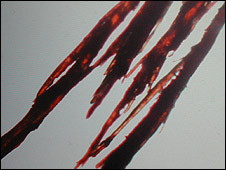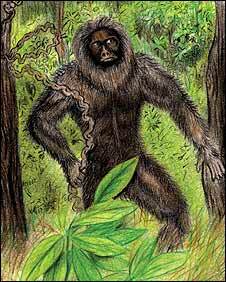
|
| © Unknown |
| The microscope revealed 'the yeti' suffered from split ends |
Scientists in the UK who have examined hairs claimed to belong to a yeti in India say that an initial series of tests have proved inconclusive.
Ape expert Ian Redmond says the hairs bear a "startling resemblance" to similar hairs collected by Everest conqueror Sir Edmund Hillary. He told the BBC the Indian hairs are "potentially very exciting". After extensive microscope examinations, the hairs will now be sent to separate labs for DNA analysis.
They say that the tests on Thursday were a "process of elimination" in which the hairs from India were compared with hairs from other animals known to live in the area around the Garo hills of the north-eastern state of Meghalaya.
The little known Indian version of the legendary yeti - or abominable snow man - is an ape-like creature called mande barung - or forest man.
The BBC was given the hairs by passionate yeti believer Dipu Marak, who retrieved them from a site in dense jungle after the mande barung was allegedly seen by a forester for three days in a row in 2003.
Mr Marak says the hairs may provide compelling evidence of the existence of a black and grey ape-like animal which stands about 3m (nearly 10ft) tall.
There have been repeated reports of sightings over many years by different witnesses in the West, South and East Garo hills.
Mr Marak estimates the creature weighs about 300kg (660lb) and says it is herbivorous, surviving on fruit, roots and tree bark.
Sophisticated microscopes
Preliminary test by the scientists in the UK have not so far disproved his belief.
"We now know for definite that these hairs do not belong to Asiatic black bear, they do not belong to a wild boar and they do not resemble hairs from various species of macaque monkeys. These hairs remain an enigma," said wildlife biologist and and ape conservation expert Ian Redmond.
"Another thing I can confirm is that if these hairs do indeed beyond to a yeti then they - like human beings - suffer from split hair ends!" he joked.

|
| © Unknown |
The tests were carried out at Oxford Brookes University in central England with award-winning primatologist Anna Nekaris and microscopy expert Jon Wells from the university's anthropology department.
Using some of the most sophisticated microscopes in Britain, the hairs were magnified up to 200 times and then compared with a database of other hairs collected by Mr Redmond from London's Natural History Museum and the primatology department at Oxford Brookes University.
To make the results as definitive as possible, the scientists took a cast of one of the two hairs brought over from India using nail varnish.
"When the varnish dries the mould which it forms creates a much better three-dimensional image than the hair itself," explained Ms Mekaris.
Disagreement
After the test were completed, Mr Redmond - who is also a senior consultant for the UN's Great Ape Survival Project - and Ms Nekaris were able to rule out the "obvious candidates" to whom the hairs might belong.
Mr Redmond said that on first glance, the hairs from India had the same follicle pattern to hairs brought back to the UK by Sir Edmund Hillary and donated to the Natural History Museum.
Both Mr Redmond and Ms Mekaris agree there is "every chance" they could belong to an unknown species of primate.
"Only two years ago a new species of macaque was discovered in northern India. It's perfectly possible that there are pockets of jungle there where a previously undiscovered ape could exist," he said.
The two scientists also pointed out that not that long ago a huge species of ape known as gigantapithecus roamed around the area.
This species was not known about until relatively recently, Mr Redmond explained, and had no fossil record.
"It was only identified when Western scientists discovered teeth found in Chinese apothecaries which it was claimed were dragons' teeth to be used for medicinal purposes.
"The teeth were examined and it was revealed that in fact they belonged to a gigantapithecus - an ape-like creature estimated to be 3m tall," he said.
The scientists say that if the Meghalayan yeti does exist it is not impossible that it was some kind of descendant of this creature.
"It could easily be an unknown primate even if it's not a yeti," said Mr Redmond. The DNA tests should cast more light on the matter.
"We are lucky that the Indian hairs have clearly identifiable follicles containing cells so there is every chance we will be able to get even closer to the truth," Mr Redmond said.



Reader Comments
to our Newsletter